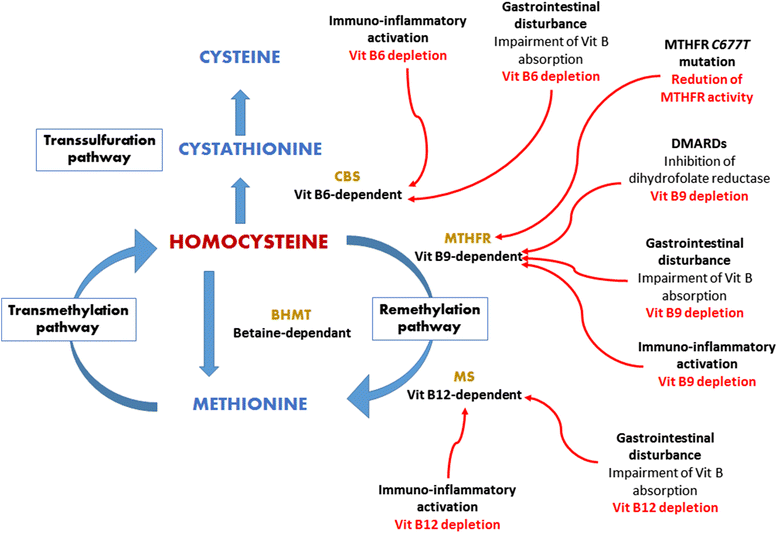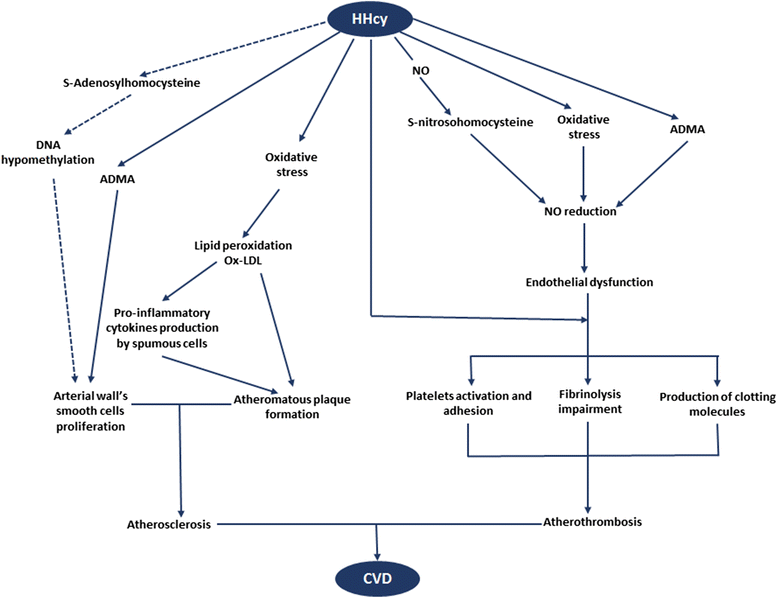Therapeutic potential of folic acid supplementation for cardiovascular disease prevention through homocysteine lowering and blockade in rheumatoid arthritis patients
- PMID: 26346508
- PMCID: PMC4559887
- DOI: 10.1186/s40364-015-0049-9
Therapeutic potential of folic acid supplementation for cardiovascular disease prevention through homocysteine lowering and blockade in rheumatoid arthritis patients
Abstract
Rheumatoid arthritis (RA) is a chronic inflammatory disease that preferentially affects joints, and characterized by an approximately two-fold increased risk of cardiovascular diseases compared with the general population. Beyond classical cardiovascular risk factors, systemic inflammatory markers are primarily involved. Hence, anti-inflammatory strategies such as homocysteine-lowering interventions are warranted. Indeed, hyperhomocysteinemia is commonly found in RA patients as a result of both genetic and non-genetic factors including older age, male gender, disease-specific features and disease-modifying antirheumatic drugs. Most importantly in the pathophysiology of hyperhomocysteinemia and its related cardiovascular diseases in RA, there is a bi-directional link between immuno-inflammatory activation and hyperhomocysteinemia. As such, chronic immune activation causes B vitamins (including folic acid) depletion and subsequent hyperhomocysteinemia. In turn, hyperhomocysteinemia may perpetrate immuno-inflammatory stimulation via nuclear factor ƙappa B enhancement. This chronic immune activation is a key determinant of hyperhomocysteinemia-related cardiovascular diseases in RA patients. Folate, a homocysteine-lowering therapy could prove valuable for cardiovascular disease prevention in RA patients in the near future with respect to homocysteine reduction along with blockade of subsequent oxidative stress, lipid peroxidation, and endothelial dysfunction. Thus, large scale and long term homocysteine-lowering clinical trials would be helpful to clarify the association between hyperhomocysteinemia and cardiovascular diseases in RA patients and to definitely state conditions surrounding folic acid supplementation. This article reviews direct and indirect evidence for cardiovascular disease prevention with folic acid supplementation in RA patients.
Keywords: Cardiovascular diseases; Folic acid supplementation; Hyperhomocysteinemia; Inflammatory biomarkers; Prevention; Rheumatoid arthritis.
Figures


Similar articles
-
DACH-LIGA homocystein (german, austrian and swiss homocysteine society): consensus paper on the rational clinical use of homocysteine, folic acid and B-vitamins in cardiovascular and thrombotic diseases: guidelines and recommendations.Clin Chem Lab Med. 2003 Nov;41(11):1392-403. doi: 10.1515/CCLM.2003.214. Clin Chem Lab Med. 2003. PMID: 14656016 Review.
-
Clinical use and rational management of homocysteine, folic acid, and B vitamins in cardiovascular and thrombotic diseases.Z Kardiol. 2004 Jun;93(6):439-53. doi: 10.1007/s00392-004-0075-3. Z Kardiol. 2004. PMID: 15252738 Review.
-
Folic acid supplementation prevents deficient blood folate levels and hyperhomocysteinemia during longterm, low dose methotrexate therapy for rheumatoid arthritis: implications for cardiovascular disease prevention.J Rheumatol. 1998 Mar;25(3):441-6. J Rheumatol. 1998. PMID: 9517760 Clinical Trial.
-
Severe atherosclerosis in rheumatoid arthritis and hyperhomocysteinemia: is there a link?Joint Bone Spine. 2008 Jul;75(4):499-501. doi: 10.1016/j.jbspin.2007.07.022. Epub 2008 May 23. Joint Bone Spine. 2008. PMID: 18457979
-
Folic acid in general medicine and dermatology.J Dermatolog Treat. 2007;18(3):138-46. doi: 10.1080/09546630701247930. J Dermatolog Treat. 2007. PMID: 17538801 Review.
Cited by
-
Breast cancer epidemic in the early twenty-first century: evaluation of risk factors, cumulative questionnaires and recommendations for preventive measures.Tumour Biol. 2016 Oct;37(10):12941-12957. doi: 10.1007/s13277-016-5168-x. Epub 2016 Jul 22. Tumour Biol. 2016. PMID: 27448308 Review.
-
The importance of homocysteine in the development of cardiovascular complications in patients with rheumatoid arthritis.Reumatologia. 2020;58(5):282-288. doi: 10.5114/reum.2020.99732. Epub 2020 Oct 12. Reumatologia. 2020. PMID: 33227081 Free PMC article. Review.
-
Gestational folate deficiency alters embryonic gene expression and cell function.Differentiation. 2021 Jan-Feb;117:1-15. doi: 10.1016/j.diff.2020.11.001. Epub 2020 Nov 27. Differentiation. 2021. PMID: 33302058 Free PMC article.
-
Determination of Folic Acid Using Biosensors-A Short Review of Recent Progress.Sensors (Basel). 2021 May 12;21(10):3360. doi: 10.3390/s21103360. Sensors (Basel). 2021. PMID: 34066085 Free PMC article. Review.
-
Vitamin D, Homocysteine, and Folate in Subcortical Vascular Dementia and Alzheimer Dementia.Front Aging Neurosci. 2017 May 30;9:169. doi: 10.3389/fnagi.2017.00169. eCollection 2017. Front Aging Neurosci. 2017. PMID: 28611659 Free PMC article.
References
-
- Meune C, Touze E, Trinquart L, Allanore Y. Trends in cardiovascular mortality in patients with rheumatoid arthritis over 50 years: a systematic review and meta-analysis of cohort studies. Rheumatol (Oxf). 2009; 10.1093/rheumatology/kep252 - PubMed
LinkOut - more resources
Full Text Sources
Other Literature Sources
Research Materials

